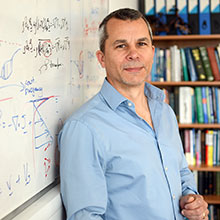Martin A. Bees
Visit Martin A. Bees's profile on the York Research Database to:
- See a full list of publications
- Browse activities and projects
- Explore connections, collaborators, related work and more
Profile
Biography
-
Former PhD student Dr Stephen O'Malley and I won the SMB 2014 Lee Segel Prize for best article coauthored by a student - O'Malley and Bees 2012
-
Former postdoc Dr Ottavio Croze has won a 5-year Winton Advanced Research Fellowship (Physics, Cambridge)
- Former PhD student Dr C. Rosie Williams won the William Jack Prize for her PhD thesis (now at British Antarctic Survey, Cambridge).
I obtained an MA in mathematics from the University of Oxford (Balliol College) before studying for a PhD in Applied Mathematics at the University of Leeds (1992-1996). My PhD work concerned nonlinear pattern generation by swimming micro-organisms. I went on to postdoctoral positions at the University of Warwick (Biology & Mathematics departments; 1996-1997) and the Chaos and Turbulence Studies group in Physics departments at the Danish Technical University and the Neils Bohr Institute, Copenhagen (1997-1998), studying plankton dynamics, bacterial swarming and hydrodynamic instabilities in chemical systems. Thereafter, I obtained a Lectureship in Mathematics at the University of Surrey (1998-2002) before moving to the University of Glasgow (2002-2012), gaining promotions to Senior Lecturer in 2004 and Reader in Applied Mathematics in 2007. I moved to the University of York in 2012 as the 50th Anniversary Professor of Mathematics.
Departmental roles
- Head of Department
Research
Overview
I have six main research areas, mostly in aspects of mathematical biology, fluid dynamics and/or pattern formation:
Bioconvection: theoretical and experimental approaches to elicit and clarify mechanisms involved in the phenomenon of phototactic and gyrotactic, bioconvection, a hydrodynamic instability induced by the biased swimming behaviour of microorganisms in suspension. The major highlights of this research have been the first quantitative experiments (Bees & Hill 1997; Williams & Bees 2011a), analyses (Bees & Hill 1998, 1998, 1999; Bees, Hill & Pedley 1998; Williams & Bees 2011b) and application of generalized Taylor dispersion theory to gyrotactic swimming microorganisms (Hill & Bees 2002; Bees & Croze 2010).
Plankton dynamics & patchiness: plankton dynamics and patchiness; chaotic advection of plankton in Langmuir circulation; bloom formation in synthetic turbulent flows; application of synchronisation theory from dynamical systems to coupled ecosystem models. Highlights have been the prediction of plankton patchiness length scales from abstract models of interacting patches employing synchronisation theory (Guirey et al. 2010), and the discovery of a new mechanism for plankton bloom formation involving inertial segregation in complex flows (Reigada et al. 2003).
Bacterial swarming: models of biofilms, and particularly bacterial swarming, incorporating thin-film fluid flow, complete wetting problems, bacterial differentiation, quorum sensing and variable viscosity fluids; experiments and theory (Bees et al. 2000, 2002). An important recent development has been the measurement of the flowfield around a constrained bacterium using PIV, and associated numerical computations, which demonstrate the importance of boundary-flagella and flagella-flagella interactions (Cisneros et al. 2008).
Chemoconvection: chemically induced hydrodynamic instabilities; we coined the term “chemoconvection” to describe these instabilities; the first models and quantitative experiments; linear, pseudo-linear; weakly-nonlinear and numerical analyses (Pons et al. 2000, 2001, 2002, 2008; Bees et al. 2001).
Ecology & biocontrol: modelling complex slug-nematode-beetle dynamics; the first rational and systematic investigation of modelling methods; discrete stages, non-autonomous delay differential equations and mass-structured systems (Bees et al. 2006); an unexpected outcome of the work was the phenomenal public interest (TV, radio and tabloids); bifurcation models of speciation (Bees, Coullet & Spiegel 2008); competition in cultures of swimming microorganisms.
Physiology: the luminance-response function of the human photopic electroretinogram; formulation of the “Glasgow” model of electrical response associated with light adaptation of the retina, for diagnosis of ocular disorders (Hamilton et al. 2007). A new collaboration looks at models of epidermal and dermal wound healing.
Research group(s)
Mathematical Biology and Chemistry
Supervision
Current Research Students
- Nick Bryant - nb1007@york.ac.uk
- James Mason - jm2303@york.ac.uk
- Matthew Sparkes - mjs572@york.ac.uk
Teaching
Undergraduate
- Classical and Biological Fluid Dynamics
Postgraduate
- Classical and Biological Fluid Dynamics


